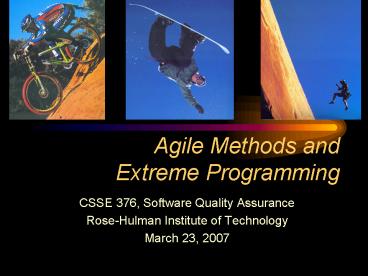Agile Methods and Extreme Programming - PowerPoint PPT Presentation
Title:
Agile Methods and Extreme Programming
Description:
'Driving is not about getting the car going in the right direction. ... Collective ownership. Continuous integration. 40-hour week. On-site customer. Coding standards ... – PowerPoint PPT presentation
Number of Views:38
Avg rating:3.0/5.0
Title: Agile Methods and Extreme Programming
1
Agile Methods andExtreme Programming
- CSSE 376, Software Quality Assurance
- Rose-Hulman Institute of Technology
- March 23, 2007
2
Outline
- Origin of Agile Methods
- Extreme Programming
- Test First Development
3
I. Origin of Agile Methods
4
First Cartoon of the Day
5
Spectrum of Methods
Source "Get ready for agile methods, with care"
by Barry Boehm, IEEE Computer, January 2002.
6
Agile Manifesto
- We are uncovering better ways of developing
software by doing it and helping others do it.
Through this work we have come to value - Individuals and interactions over processes and
tools - Working software over comprehensive documentation
- Customer collaboration over contract negotiation
- Responding to change over following a plan
- That is, while there is value in the items on the
right, we value the items on the left more.
7
Some Agile Methods
- ASD - Adaptive Software Development
- Crystal
- FDD - Feature Driven Development
- DSDM - Dynamic Systems Development Method
- Lean Software Development
- Scrum
- XP - eXtreme Programming
8
II. Extreme Programming
9
Motivation
- Knobs on a control board
- Each knob a practice that works well
- Turn all knobs up to 10
10
Learning to Drive
- "Driving is not about getting the car going in
the right direction. - Driving is about constantly paying attention,
making a little correction this way, a little
correction that way." - -- Kent Beck, Extreme Programming Explained
11
Four Values
- Simplicity
- create the simplest thing that could work
- Communication
- face-to-face, not document-to-face
- Feedback
- lots of tests
- Aggressiveness
12
Four Basic Activities
- Coding
- cannot do without it
- Testing
- if it cannot be tested it doesn't exist
- Listening
- to those with domain knowledge
- Designing
- to keep the system from decaying
13
Twelve Practices
- Pair programming
- Collective ownership
- Continuous integration
- 40-hour week
- On-site customer
- Coding standards
- The Planning Game
- Small releases
- Metaphor
- Simple design
- Testing
- Refactoring
14
Waterfall to XP Evolution
Source "Embracing change with extreme
programming" by Kent Beck,IEEE Computer, October
1999.
15
5. Testing
- Any feature without an automated test does not
exist. - Programmers need confidence in correct operation
- Customers need confidence in correct operation
16
Tools for Testing
- Test harnesses for various programming languages
- Simplify job of creating and running the tests
17
Second Cartoon of the Day
18
7. Pair Programming
- All code written with 2 people at one machine
- Driver
- thinks about best way to implement
- Passenger
- thinks about viability of whole approach
- thinks of new tests
- thinks of simpler ways
19
Workspace
20
9. Continuous Integration
- Integrate and test every few hours, at least once
per day - All tests must pass
- Easy to tell who broke the code
21
III. Test First Development
22
Code the Unit Test First
- Makes it easier to write the code
- Translates requirements to specific tasks that
must be accomplished by code - Creates tests at moments when they can best be
defined - Provides immediate feedback to coding
23
Similar to Deming's PDSA Cycle (below)
- Plan Write a test case expressing what you hope
to accomplish. - Do Write the code.
- Study Run the test.
- Act If it passes, check the code in and go on.
If it fails, rerun the cycle. Maybe the code is
bad or maybe the test is bad.
24
Side Effects
- Designing in small steps
- only need to do a little bit at a time
- A sense of unhurriedness
- always know what you are doing and when you are
done - Monological thinking
- focus on one thing at a time































